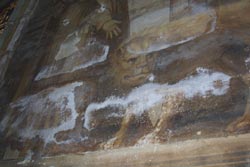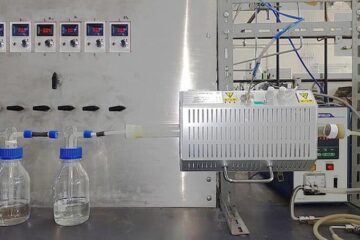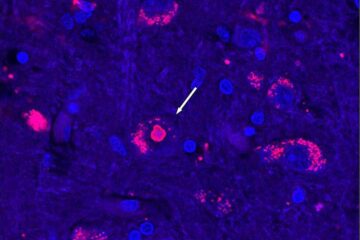New mineralogical techniques contribute to prevent national heritage damage

Salts in the mural paintings of the upper section of the Church of the Monastery of San Jerónimo (Granada).<br>
Humidity, environmental pollution, cleaning with aggressive products for the chemical composition of the rock, etc give rise to the appearance of salts which cause stone decomposition, paint coats detachment, dust accumulation, etc.
The treatments used up to now to deal with the problem have been directed, almost exclusively, to preserve the beauty of the affected monument, assuming, with an almost fatalist attitude, that the damage will go on as an effect of passing of time.
European experts joint in the SALTCONTROL project have collaborated in a new work line to deal with the problem: Blocking inside the stone the mineral salt crystallization process that ends up destroying it.
One of the works carried out in the framework of SALTCONTROL is the doctoral thesis “Prevención del daño debido a cristalización de sales en el patrimonio histórico construido mediante el uso de inhibidores de cristalización” (Damage prevention due to salt crystallization in national heritage through the use of crystallization inhibitors), read by Encarnación María Ruiz Agudo, under the supervision of Prof Carlos Manuel Rodríguez Navarro; as well as several papers published by scientific journals such as Journal of Physical Chemistry, Environmental Geology, Scanning y Journal of the Japanese Association for Crystal Growth.
According to Ruiz Agudo (Centro Andaluz del Medio Ambiente – Department of Mineralogy and Petrology of the University of Granada) “ornamental porous materials’ damage due to salt attack is one of the most aggressive alteration mechanisms that affect constructed heritage. In the last decades, we have developed different methods to prevent or reduce the damage due to salt crystallization in ornamental rock pores, almost all with little success”.
The thesis’s research line and the above mentioned papers have followed the recent techniques that intend to use additives to modify the crystallization process and prevent or reduce the damage produced in the rock. Up to now, most of the works in this field have assessed the efficiency of these treatments in slightly soluble salts, such as calcium and barium sulphates. The thesis “has proved the effectiveness of this type of treatment in highly soluble salts, such as sodium and magnesium sulphates, as well as sodium nitrate, which can usually be found in historic buildings”.
Applied science
The research work has been applied to the case of the effects of these treatments in the rock extracted in Santa Pudia’s quarries (Escúzar,-Granada), used in the construction of Renaissance buildings in Granada such as the Monastery of San Jerónimo, the Cathedral or the Royal Chapel. These buildings show strong alteration phenomenon due to crystallization in sodium sulphate, magnesium and sodium nitrate.
The work has conducted to the carrying out of salt crystallization tests in laboratory, which simulate alteration processes due to salt crystallization in the bases on historic buildings’ walls. “Later –says Ruiz Agudo-, we prepared a method for the implementation of the treatment developed in practical cases of ornamental stone materials conservation. Finally, in a last phase of development of the research project, we applied such treatment in pilot areas on the Monastery of San Jerónimo (Granada), where there had been important problems due to salt crystallization”.
The final result of the research work proposes the application of low-cost additives, which have proved to be very effective in the fight against the problems of ornamental porous materials. On the other hand, the research work “involves a methodology to deal with the study of damage caused by salts and the selection of the most adequate type of additive for a specific substrate and type of salt. The object of the methodology is the study of the problem in situ, in order to carry out laboratory tests that allow to select the concentration, pH and the most appropriate application method and finally to go back to the building to test the treatment in pilot areas, which permits to guarantee the success in the application of salt crystallization inhibitors inside stony materials, as we have proved in San Jerónimo”.
SALTCONTROL
The research work is part of the SALTCONTROL project, financed by the 6th framework Programme of the EU for the period 2004-2007. Together with the University of Granada, other organisms have participated in the project: the University of Münster (Germany), the University of Gant (Belgium), the University College of London, the University of Patras in Greece, the Technical University of Prague, the Architecture Conservation Centre TNO of Holland, the Andalusian Institute of National Heritage and the Technical University of Eindhoven.
SALTCONTROL’s results have been successfully applied in the Monastery of San Jerónimo (Granada-Spain) and the Fortress of Teresina (Prague, Czech Republic).
Reference: Encarnación Mª Ruiz Agudo. Dpt Mineralogy and Petrology. Phone numbers. 958248535 – 958 24 8535. E-mail. encaruiz@ugr.es. Prof Carlos Manuel Rodríguez Navarro. Phone number. 958246616. E-mail. carlosrn@ugr.es
Media Contact
More Information:
http://www.ugr.esAll latest news from the category: Architecture and Construction
Newest articles

Recovering phosphorus from sewage sludge ash
Chemical and heat treatment of sewage sludge can recover phosphorus in a process that could help address the problem of diminishing supplies of phosphorus ores. Valuable supplies of phosphorus could…

Efficient, sustainable and cost-effective hybrid energy storage system for modern power grids
EU project HyFlow: Over three years of research, the consortium of the EU project HyFlow has successfully developed a highly efficient, sustainable, and cost-effective hybrid energy storage system (HESS) that…

After 25 years, researchers uncover genetic cause of rare neurological disease
Some families call it a trial of faith. Others just call it a curse. The progressive neurological disease known as spinocerebellar ataxia 4 (SCA4) is a rare condition, but its…





















